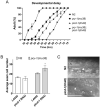Cabin1 domain-containing gene picd-1 interacts with pry-1/Axin to regulate multiple processes in Caenorhabditis elegans
- PMID: 35835800
- PMCID: PMC9283418
- DOI: 10.1038/s41598-022-15873-5
Cabin1 domain-containing gene picd-1 interacts with pry-1/Axin to regulate multiple processes in Caenorhabditis elegans
Abstract
The Axin family of scaffolding proteins control diverse processes, such as facilitating the interactions between cellular components and providing specificity to signaling pathways. While several Axin family members have been discovered in metazoans and shown to play crucial roles, their mechanism of action are not well understood. The Caenorhabditis elegans Axin homolog, pry-1, is a powerful tool for identifying interacting genes and downstream effectors that function in a conserved manner to regulate Axin-mediated signaling. Our lab and others have established pry-1's essential role in developmental processes that affect the reproductive system, seam cells, and a posterior P lineage cell, P11.p. Additionally, pry-1 is crucial for lipid metabolism, stress responses, and aging. In this study, we expanded on our previous work on pry-1 by reporting a novel interacting gene named picd-1 (pry-1-interacting and Cabin1 domain-containing). PICD-1 protein shares sequence conservation with CABIN1, a component of the HUCA complex. Our findings have revealed that PICD-1 is involved in several pry-1-mediated processes, including stress response and lifespan maintenance. picd-1's expression overlapped with that of pry-1 in multiple tissues throughout the lifespan. Furthermore, PRY-1 and PICD-1 inhibited CREB-regulated transcriptional coactivator homolog CRTC-1, which promotes longevity in a calcineurin-dependent manner. Overall, our study has demonstrated that picd-1 is necessary for mediating pry-1 function and provides the basis to investigate whether Cabin-1 domain-containing protein plays a similar role in Axin signaling in other systems.
© 2022. The Author(s).
Conflict of interest statement
The authors declare no competing interests.
Figures










Similar articles
-
Genetic analysis of Caenorhabditis elegans pry-1/Axin suppressors identifies genes involved in reproductive structure development, stress responses, and aging.G3 (Bethesda). 2022 Feb 4;12(2):jkab430. doi: 10.1093/g3journal/jkab430. G3 (Bethesda). 2022. PMID: 35100345 Free PMC article.
-
Role of PRY-1/Axin in heterochronic miRNA-mediated seam cell development.BMC Dev Biol. 2019 Jul 15;19(1):17. doi: 10.1186/s12861-019-0197-5. BMC Dev Biol. 2019. PMID: 31307392 Free PMC article.
-
PRY-1/Axin signaling regulates lipid metabolism in Caenorhabditis elegans.PLoS One. 2018 Nov 7;13(11):e0206540. doi: 10.1371/journal.pone.0206540. eCollection 2018. PLoS One. 2018. PMID: 30403720 Free PMC article.
-
Axin Family of Scaffolding Proteins in Development: Lessons from C. elegans.J Dev Biol. 2019 Oct 15;7(4):20. doi: 10.3390/jdb7040020. J Dev Biol. 2019. PMID: 31618970 Free PMC article. Review.
-
AXIN-AMPK signaling: Implications for healthy aging.F1000Res. 2021 Dec 8;10:1259. doi: 10.12688/f1000research.74220.1. eCollection 2021. F1000Res. 2021. PMID: 35087668 Free PMC article. Review.
Cited by
-
Neurotrophic factor MANF regulates autophagy and lysosome function to promote proteostasis in C. elegans.bioRxiv [Preprint]. 2024 Jan 4:2023.07.31.551399. doi: 10.1101/2023.07.31.551399. bioRxiv. 2024. Update in: Proc Natl Acad Sci U S A. 2024 Oct 22;121(43):e2403906121. doi: 10.1073/pnas.2403906121. PMID: 38260421 Free PMC article. Updated. Preprint.
-
pry-1 interacts with bar-1 to regulate vit-2 expression, lipid levels, and lifespan in Caenorhabditis elegans adults.MicroPubl Biol. 2023 Oct 20;2023:10.17912/micropub.biology.000987. doi: 10.17912/micropub.biology.000987. eCollection 2023. MicroPubl Biol. 2023. PMID: 37927912 Free PMC article.
-
The FGFR4 Homolog KIN-9 Regulates Lifespan and Stress Responses in Caenorhabditis elegans.Front Aging. 2022 May 20;3:866861. doi: 10.3389/fragi.2022.866861. eCollection 2022. Front Aging. 2022. PMID: 35821842 Free PMC article.
-
The Histone Chaperone Network Is Highly Conserved in Physarum polycephalum.Int J Mol Sci. 2023 Jan 5;24(2):1051. doi: 10.3390/ijms24021051. Int J Mol Sci. 2023. PMID: 36674565 Free PMC article.
References
Publication types
MeSH terms
Substances
Grants and funding
LinkOut - more resources
Full Text Sources
Research Materials
Miscellaneous

